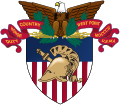
The United States Military Academy (USMA) is a United States service academy in West Point, New York. It was originally established as a fort during the American Revolutionary War, as it sits on strategic high ground overlooking the Hudson River 50 miles (80 km) north of New York City. It is the oldest of the five American service academies and educates cadets for commissioning into the United States Army.

West Point Cemetery is a historic cemetery on the grounds of the United States Military Academy in West Point, New York. It overlooks the Hudson River, and served as a burial ground for Continental Army soldiers during the American Revolutionary War, and for early West Point residents prior to its designation as a military cemetery in 1817.

"The Corps" is a poetic hymn associated with the United States Military Academy. It is second in importance to only the Academy's Alma Mater. The words were written by West Point Chaplain, Bishop H.S. Shipman, around 1902. The accompanying music was composed in 1910 specially for the ceremonial closing of the Old Cadet Chapel and opening of the new Cadet Chapel. "The Corps" was first sung on the steps of the Cadet Chapel on 12 June 1910, and became part of the graduation ceremony starting in 1911. Today, "The Corps" is typically sung by the Cadet Glee Club in companion to the Alma Mater at alumni gatherings, graduation, memorial ceremonies and funerals.

The United States Military Academy and grounds were declared a National Historic Landmark in 1960 due to the Revolutionary War history and the age and historic significance of the academy itself. The majority of the buildings in the central cadet area are historic.
The history of the United States Military Academy can be traced to fortifications constructed on the West Point of the Hudson River during the American Revolutionary War in 1778. Following the war, President Thomas Jefferson signed legislation establishing the United States Military Academy (USMA) on the site in 1802. In 1817 the academy was transformed by the appointment of Sylvanus Thayer who drastically reformed the curriculum.

Battle Monument is a large Tuscan column monument located on Trophy Point at the United States Military Academy, West Point, New York, designed by Stanford White.
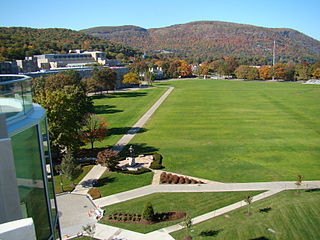
The Plain is the parade field at the United States Military Academy at West Point, New York. The flat terrain of the Plain is in contrast to the varied and hilly terrain of the remainder of the campus. The Plain rises approximately 150 feet (45 m) above the Hudson River and has been the site of the longest continually occupied U.S. Army garrison in America since 1778. In its early years, the entire academy was located on the Plain and it was used for varying activities ranging from drill and mounted cavalry maneuvers to an encampment site for summer training to a sports venue. Currently, the Plain refers to just the parade field where cadets perform ceremonial parades.

Kościuszko's Monument is a pedestal and statue of Polish General Tadeusz Kościuszko at the United States Military Academy at West Point, New York. Kościuszko designed the defenses of the West Point garrison from 1778–1780 during the height of the Revolutionary War, when George Washington considered West Point to be the most important military post in America. The pedestal and shaft of the monument was first proposed in 1825 by John Latrobe, and dedicated in 1828. The statue, designed by D. Borja, was later added in 1913.
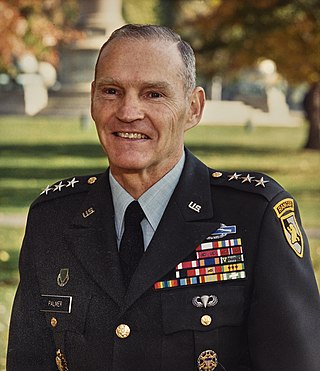
Dave Richard Palmer is a retired United States Army Lieutenant General who served as the 53rd Superintendent of the United States Military Academy (1986–1991), military historian and author, and former President of Walden University. A 1956 graduate of West Point, he served two tours in the Vietnam War and numerous command positions during the height of the Cold War. He taught courses at both West Point and the Vietnamese National Military Academy.
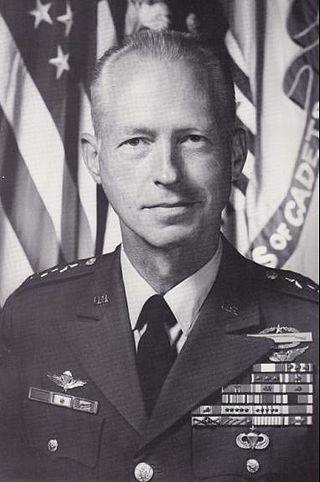
Sidney Bryan Berry was a United States Army Lieutenant General, Superintendent of West Point (1974–1977), and Commissioner of Public Safety for the state of Mississippi (1980–1984).

The Chapel of the Most Holy Trinity at the United States Military Academy is a Catholic church and place of worship for many members of the United States Military Academy Corps of Cadets. Completed in 1900, it is the oldest chapel on the West Point campus in continual use, although the 1836 Old Cadet Chapel, moved in 1910 to West Point Cemetery, is still in use for funeral services and weekly Lutheran denominational services. Most Holy Trinity Chapel was expanded in 1959.

Dade Monument is a monument and United States Military Academy Cemetery, in honor of Major Francis L. Dade and his command of 110 men who were defeated by Seminole warriors at Dade Massacre on 28 December, 1835. The monument has moved several times in its history. First erected in 1845, it originally stood overlooking the Hudson River on the east edge of the Plain. It was moved further inland prior to 1898 to make way for the construction of Cullum Hall. In 1917 it was moved further south in front of the Old Cadet Library. In 1948, it was relocated to its current location near the entrance to the West Point Cemetery to make way for the Patton Monument.

L'Ecole Polytechnique Monument is a statue and monument located at the United States Military Academy in West point, New York. It is a replica of a statue at École Polytechnique that commemorates the cadets of that French school who died in defense of France in 1814. In 1919, in the wake of Franco-American cooperation in the First World War, an association of alumni of the École Polytechnique presented a full-size casting of the statue to West Point as a symbol of brotherhood between the two nations and schools.

Wood's Monument is an obelisk monument in honor of Colonel Eleazer Derby Wood (1783–1814), an engineer officer and early graduate of West Point who died during the War of 1812 at the Siege of Fort Erie on 17 September 1814. Old prints of West Point show this monument located on a knoll near the flag pole. The monument was once used as a navigational aid for ships making the passage down the Hudson River.
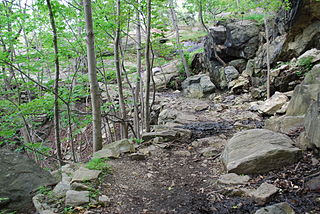
Flirtation Walk is a historic rocky foot trail at the United States Military Academy. The trail follows the shoreline of the Hudson River along the western bank. The southern trailhead starts at the edge of the Lincoln Hall parking lot and winds north along the river around Gee's Point and the West Point Light. The trail turns west-northwest, passing Battery Cove, where the Great Chain was anchored during the Revolutionary War. The trail ends near the helipad of West Point's North Dock. There also is an access trail that descends steeply to the river level from Trophy Point. The trail varies in consistency from level and even to steep and rocky. By academy tradition, only cadets and their guests may use the trail. Visitors escorted by cadets should wear sturdy shoes. The 1934 film Flirtation Walk was named after the trail. The film was nominated for the Academy Award for Best Picture.

Custer Monument is a monument at the United States Military Academy Cemetery, in honor of Lieutenant Colonel George Armstrong Custer who was killed along with his immediate command at the Battle of the Little Bighorn on 25 June 1876. Congress approved of a statue, to be made from 20 condemned bronze cannons, and for $10,000, of which $6,000 had been subscribed by citizens of New York. The monument was originally located near the academy's headquarters building near the site of present-day Taylor Hall along Thayer Road. Unveiled in 1879, the pedestal had a bronze statue of Custer wielding a saber and a pistol. Custer's widow and many officers did not approve of this likeness and after only five years, the statue was removed and sent to New York City where Stanford White was supposed to remove the bust, to be displayed in the library. However, after White's murder, its whereabouts have since been lost. The pedestal was moved to Custer's grave site in the West Point Cemetery during the construction of Taylor Hall around 1910. In 1965, a stone obelisk was placed atop the pedestal.

Brigadier General Thaddeus Kościuszko is a bronze statue honoring Polish military figure and engineer Tadeusz Kościuszko. The sculpture was dedicated in 1910, the third of four statues in Lafayette Square, Washington, D.C., to honor foreign-born heroes of the American Revolutionary War. Born in the Polish–Lithuanian Commonwealth in 1746, Kościuszko later received education at a Jesuit school before attending the Corps of Cadets in Warsaw. He later traveled to France where he studied in military academy libraries and adopted views of human liberty during the Age of Enlightenment. He moved to the Thirteen Colonies in 1776, where the war with the Kingdom of Great Britain had already begun. Kościuszko served as an engineer in the Continental Army, earning the praise of his superiors, including General George Washington.
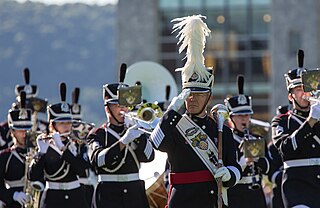
The West Point Band is the U.S. Army's oldest active band and the oldest unit at the United States Military Academy, traces its roots to the American Revolutionary War. At that time, fifers and drummers were stationed with companies of minutemen on Constitution Island, across the river from West Point. In 1778, General Samuel Holden Parsons' 1st Connecticut Brigade crossed the Hudson River and established West Point as a permanent military post. After the American Revolution, Congress disbanded most of the Continental Army, but "the 55 men at West Point", members of the 2nd Continental Artillery, remained as they were. Among their ranks stood at least one drummer and one fifer, who alone maintained the tradition of military music at West Point.
Erwin Frey was an American sculptor and educator best remembered for his George Armstrong Custer memorial.





































